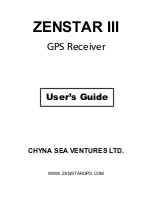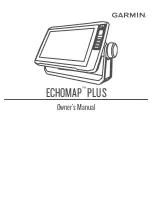
142
Z-Max Surveying System Operation and Applications Manual
3. Initialize on a known point
Initialization of your kinematic survey can be accomplished by collecting a short
amount of data on a point whose position is very well known with reference to the
location of the kinematic base station. This is the quickest method for kinematic
initialization, requiring approximately 10 seconds of observation time on the
known point. The following scenario is an example where this type of initialization
would be used:
You arrive on a new project site where you need to perform a kinematic
survey. You set up the base station on an existing point with known
coordinates or an arbitrary point where approximate coordinates will be
assigned. You assign a point ID of 0001 to your base point. You drive a PK
nail into the ground to mark your initialization point. You assign a point ID of
0100 to your initialization point. You then initialize your kinematic survey by
first performing a static survey on your initialization point. Once initialized, you
proceed to position new points using the kinematic mode. You successfully
position 10 points when you suddenly lose lock on satellites due to an
obstruction (the Z-Max receiver will sound an alarm when fewer than 5
satellites are locked). You must now re-initialize your survey.
You can re-initialize the survey by returning to your initialization point (0100)
and observing it once again, but this time your observation needs to be only
10 seconds in duration because this point is now a known point. Your
initialization point is a known point because you successfully performed a
static survey on this point earlier. When you observe your initialization point
the second time, you need to assign it the same point ID as your first
observation (0100). By doing so, the post-processing software will know that
these are observations on the same point.
Point Observation
When initialized, all the data collected by the rover system will produce centimeter-
level results, whether walking around the project area or positioned over a feature. If
your recording interval is set to 2 seconds, data samples (epochs) are written to
memory every 2 seconds, all of which are processed by the post-processing software
to generate centimeter-level positions. If you are walking around the project site, a
position is calculated every 2 seconds producing a virtual trail of where you walked. If
you stop and observe a feature of interest for 10 seconds, five data samples are
observed for this feature, producing a more precise position than those produced
while walking. The ability to determine positions while observing a feature for a period
of time and the ability to determine positions while moving around the project site
illustrates the two modes of post-processed kinematic positioning. These two modes
are termed Continuous Kinematic and Stop&Go Kinematic.
G3.book Page 142 Saturday, May 24, 2003 12:52 PM
Содержание Z-Max
Страница 1: ...Z Max Operation and Applications Manual www thalesnavigation com THALES NAVIGATION ...
Страница 15: ...xiv Z Max Surveying System Operation and Applications Manual G3 book Page xiv Saturday May 24 2003 12 52 PM ...
Страница 21: ...xx Z Max Surveying System Operation and Applications Manual G3 book Page xx Saturday May 24 2003 12 52 PM ...
Страница 22: ...Reliance Fundamentals SECTION 1 Operation and Reference Guide G3 book Page 21 Saturday May 24 2003 12 52 PM ...
Страница 23: ...Z Max Surveying System Operation and Applications Manual G3 book Page 22 Saturday May 24 2003 12 52 PM ...
Страница 53: ...30 Z Max Surveying System Operation and Applications Manual G3 book Page 30 Saturday May 24 2003 12 52 PM ...
Страница 116: ...Reliance Fundamentals SECTION 2 System Guide to Post process Surveying G3 book Page 93 Saturday May 24 2003 12 52 PM ...
Страница 117: ...Z Max Surveying System Operation and Applications Manual G3 book Page 94 Saturday May 24 2003 12 52 PM ...
Страница 135: ...112 Z Max Surveying System Operation and Applications Manual G3 book Page 112 Saturday May 24 2003 12 52 PM ...
Страница 173: ...150 Z Max Surveying System Operation and Applications Manual G3 book Page 150 Saturday May 24 2003 12 52 PM ...
Страница 174: ...Reliance Fundamentals SECTION 3 System Guide to RTK Surveying G3 book Page 151 Saturday May 24 2003 12 52 PM ...
Страница 175: ...Z Max Surveying System Operation and Application Manual G3 book Page 152 Saturday May 24 2003 12 52 PM ...
Страница 201: ...178 Z Max Surveying System Operation and Applications Manual G3 book Page 178 Saturday May 24 2003 12 52 PM ...
Страница 239: ...216 Z Max Surveying System Operation and Applications Manual G3 book Page 216 Saturday May 24 2003 12 52 PM ...
Страница 263: ...240 Z Max Surveying System Operation and Applications Manual G3 book Page 240 Saturday May 24 2003 12 52 PM ...
Страница 275: ...252 Z Max Surveying System Operation and Applications Manual G3 book Page 252 Saturday May 24 2003 12 52 PM ...
Страница 295: ...272 Z Max Surveying System Operation and Applications Manual G3 book Page 272 Saturday May 24 2003 12 52 PM ...
Страница 297: ...274 Z Max Surveying System Operation and Applications Manual G3 book Page 274 Saturday May 24 2003 12 52 PM ...
Страница 301: ...278 Z Max Surveying System Operation and Applications Manual G3 book Page 278 Saturday May 24 2003 12 52 PM ...
















































